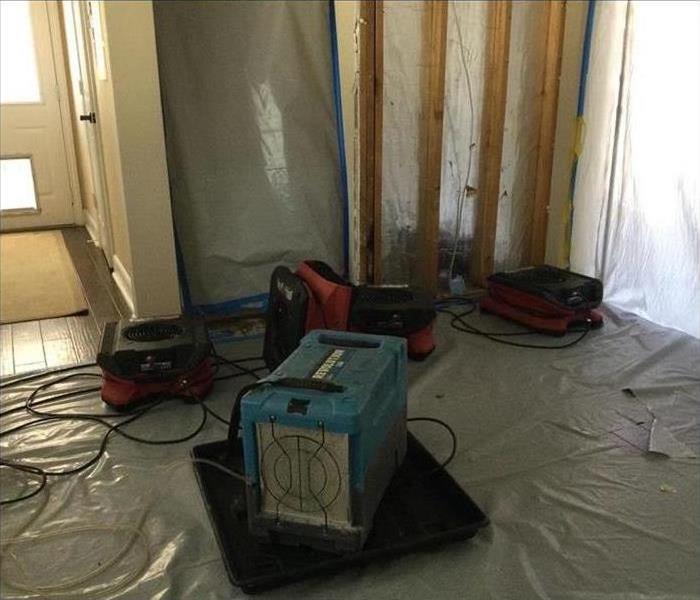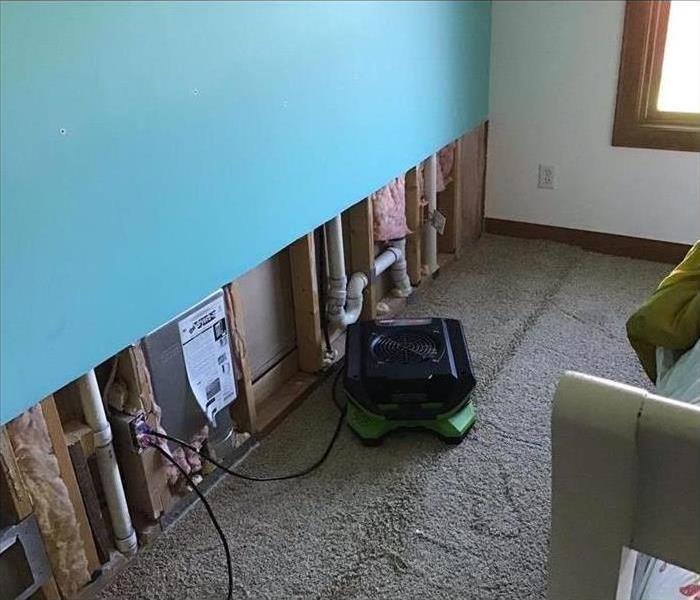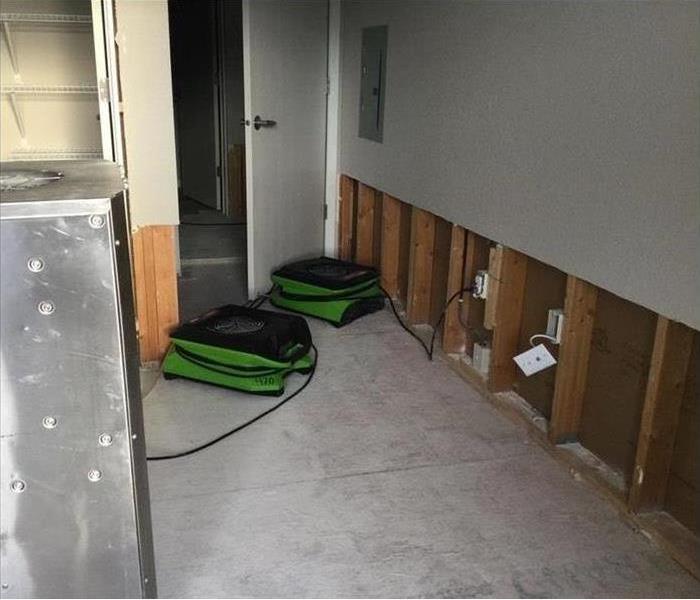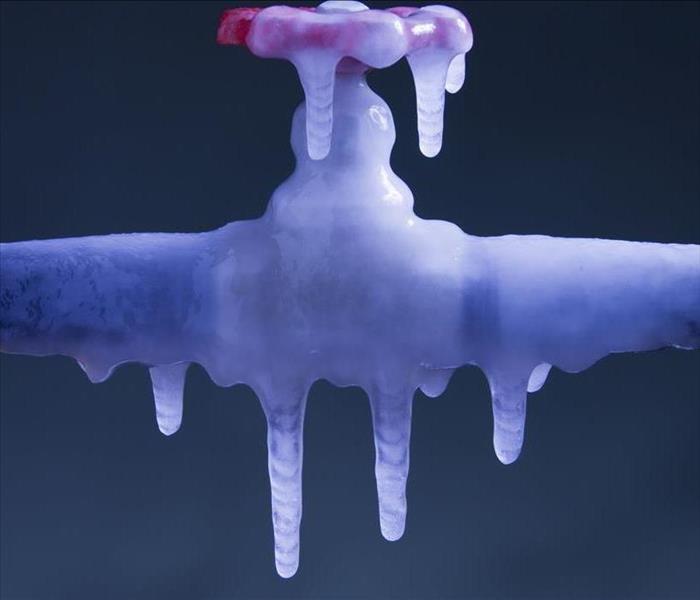Recent Water Damage Posts
Water Damage Restoration: A SERVPRO® Short Story
8/14/2023 (Permalink)
Have you ever wondered what a day in the life of a SERVPRO® technician looks like? Read Emily's story below to get a sneak peek!
Water Damage Restoration Short Story
In the heart of a rain-soaked town, a SERVPRO technician named Emily was a silent hero working to undo the havoc wreaked by a sudden and merciless storm. As dawn broke, the phone rang, summoning her to a home that had become a victim of relentless flooding.
Arriving at the scene, Emily stepped into ankle-deep water, her SERVPRO uniform ready to bear witness to the challenging task ahead. With a determined nod, she began her meticulous dance with the water's chaos.
First, Emily assessed the extent of the water damage, a critical step that would shape her plan of action. She meticulously cataloged the affected areas, from drenched carpets to soggy walls, ensuring no detail escaped her watchful eye.
Equipped with an arsenal of specialized tools, Emily initiated the water extraction process. Her nimble fingers worked deftly as she wielded industrial-grade pumps, swiftly draining the stagnant water that had invaded the home's sanctity. Her movements were deliberate, each action inching the house closer to its former glory.
As the last of the water vanished, Emily's focus shifted to drying and dehumidifying the space. She strategically placed high-powered air movers and dehumidifiers, orchestrating a symphony of airflow that whisked away moisture, one molecule at a time. It was a delicate ballet of science and technique, executed flawlessly by Emily's experienced hands.
With the environment primed, Emily turned her attention to the aftermath of the flood: damaged furniture, warping wood, and the musty scent that clung to the air. Her skilled touch brought these elements back to life. She meticulously cleaned and sanitized surfaces, her meticulous efforts erasing any traces of the disaster.
Emily's dedication was more than just a job; it was an act of restoring normalcy to a family's life. The gratitude in their eyes as they surveyed their rejuvenated home was the ultimate reward for her hard work.
In the end, Emily stood amidst a scene of triumph. The water damage had been tamed, the chaos quelled. Her role as a SERVPRO technician had not only salvaged a house but also rekindled hope. And as Emily left the once-flooded home, her steps were light with the knowledge that she had made a difference – one that would resonate long after the floodwaters had receded.
Water Damage Repair Timeline
9/19/2022 (Permalink)
The annoyance and ruination of water damage happens to U.S. homeowners a troubling 14,000 times a day. Statistically speaking, it’s happening at least once somewhere in America while you read this paragraph. And there it goes again.
Obviously, we hope your home stays bone dry as long as you live there, but should the day arise when you need emergency assistance from SERVPRO, here’s how all that will go.
Emergency Contact. When you reach out in a panic, we’ll reassure you and walk you though some guiding questions to help us understand the situation and start putting a plan together. Then we’ll set a time to meet in person. All of this will happen quickly.
Inspection and Water Damage Assessment. Once we arrive on the scene, we can flesh out the plan and stop any water that may still be flowing. We’ll make sure you know if the encroaching water has created any hazards on your property, and we’ll also give you an idea of the items or materials that will likely need replacement.
Water Removal. You’ll never get all that water out with a bucket or a regular water vacuum. That’s why we bring our pumps to make quick work of it.
Damaged Material Removal. The items that are unable to be restored can now be hauled away, expediting the process of restoration for the items and materials that remain.
Cleaning, Sanitizing and Deodorization. Water damage can leave a yucky mess. We’ll use our tools and some old-fashioned elbow grease to rid your home of unwanted stains, smells and depending on the nature of your emergency, harmful contaminants.
Drying. It’s only a short while after water invades that mold begins to grow. Even after the water is pumped out, your home will need some dehumidifying and drying out.
Monitoring. We’ll be carefully watching the entire process, making sure every box is ticked and every surface is cleaned and dried. Don’t you worry about a thing.
Repairs and Construction. Now that everything is dry and in order, we can go about the finishing touches, which may range from replacing carpet to reconstructing entire rooms. Large or small, we’ll be there to oversee every aspect of your water damage restoration.
Preventing Spring Water Damage
3/14/2022 (Permalink)
We all know the old saying, "April showers bring May flowers." With springtime comes melting snow and heavy downpours, which can bring unwanted surprises to light on your property like roof leaks or water that comes through in your basement's foundation. Soggy carpet and dripping ceilings often lead to water damage. Have no fear! Taking the following steps can help prevent water damage in the spring.
Tips to Prevent Springtime Water Damage
- Groom your gutters. Keep the flow flowing! By cleaning your gutters and keeping them damage free, water will be directed away from your house with downspout extensions.
- Cover up! Using plastic covers around window wells can keep rain from seeping in.
- Show your roof some love. Give your roof some much needed TLC by replacing missing singles, any damage from storms or weather, and keep flashing sealed. We promise it's worth the effort!
- Be an Einstein landscaper. When putting decoration or landscaping around your home, make sure to slope the ground away from your foundation. This will help prevent water from pooling and causing future water damage issues.
- It's all about the foundation. By repairing cracks and holes in your home's foundation as soon as they are found, you can keep the water away and minimize your odds of water damage!
Here at SERVPRO of Minneapolis, we know that water damage can be a hassle. If you follow the above tips, you might just save yourself from seeing our bright green vans. Whether you use our tips or not, water damage can still happen. That's where we come in!
Give us a call at 952-426-4847 at any hour of the day! We've got technicians at the ready to help you in your time of need.
How To Tell If Water Damage Is Old
3/7/2022 (Permalink)
As water damage restoration experts, we understand the issues that water damage presents, especially when it isn't in your sight. When discovered, water spots are clues that indicate a leaky pipe or condensation that is generating the problem.
Even though it impossible to know exactly how long your water damage issues have lingered, there are steps you can take to tell if your water damage is old or new.
Steps to Determining if your Water Damage is Old
- Review the history of the house. As soon as water spots are discovered, take note of when you found them. IT's important to recognize and understand what is new and what is old because smaller leaks can take months to appear.
- Touch the water spot. Water damage drywall or a water damage ceiling spot will be mushy and squishy since the material will have soaked up a fair amount of water. A newer spot will be wet, but the drywall and ceiling will remain strong.
- Examine the materials. It's important to know what materials your walls and ceilings are composed of because thick paint or tiles can trap water. If this is the circumstance, even a small spot where there is water damage can indicate that it has been around for awhile.
Are you still unsure how to tell if water damage is old or new? Give us a call today!
As your local water damage repair company, we can fix drywall water damage! For all of your water damage restoration needs, get in touch with us. When there's a lea that you cannot detect, it is crucial to contact an expert like us!
Tips for Preventing Water Damage in your Home
3/4/2022 (Permalink)
 Here is daily departure photo of rooms with fans after water damage has occurred.
Here is daily departure photo of rooms with fans after water damage has occurred.
Water damage is one of the most common structural damage problems home and business owners have to deal with. Unlike other types of damage, which tend to be sudden and easy to notice, water damage usually happens slowly over time and is not noticeable until it's too late. However, some types of water damage, such as those from hurricanes and thunderstorms, can occur very quickly with disastrous results.
If you want to make sure that you never have to call for a water damage restoration company near you, it's best to prepare your property for water damage before disaster strikes.
The easiest way to avoid having to call an excellent water damage restoration company such as ours is to try to avoid water damage altogether. Although this can be a tall order, especially within storm season, that gives you all the more reason to be prepared.
4 Essential Water Damage Prevention Practices:
Fix and renovate your plumbing.
Most people associate water damage with thunderstorms and hurricanes, when in reality, the real problem is bad plumbing. Whether it's a new but poorly constructed building or an older building that has had no plumbing renovation in decades - a water pipe burst in a house can wreak havoc either way. Updating your plumbing can be as simple as starting with the hoses and faucets and then you can move on to the seals and pipes.
Take care of your building's exterior structure.
Storms and other disastrous weather conditions are a primary task for water restoration companies. To avoid having to deal with the consequences of a weather disaster, it is crucial to renovate your building's exterior by:
- Caulking and sealing windows
- Installing impact windows
- Replace missing or damage shingles on your roof
- Clean downspouts and install gutter guards
- Repair outside walls if they are not fully sealed
Prevent water seepage by resealing your basement.
Basement water damage restoration is extremely common for our business. It is an extremely common area or water seepage to occur. Routinely check for cracks in the building's foundation and floor slabs - make it an effort to reseal them. Be sure to install backwater valves to your sewage system to help avoid sewer backup.
Keep your eyes peeled for mold growth.
Mold is not only caused by water damage, but it also causes further water damage by eroding your building's foundation. Check for mold growth in your basement, crawlspace, and roof to make sure that your structure is in superior condition.
If you are unsure whether or not you have water damage or mold damage, we are a water damage restoration resource for you. Give us a call with any of your needs.
Traveling Water Issues in Minnetonka, MN
3/2/2022 (Permalink)
 Whether you live near Lake Minnetonka, in the urban areas of Minneapolis and St. Paul, or in surrounding communities, we can help!
Whether you live near Lake Minnetonka, in the urban areas of Minneapolis and St. Paul, or in surrounding communities, we can help!
Traveling Water Damage
When your property faces water damage, it can be an eye-opening experience. The effects of water damage can be extremely daunting as the building's materials and your personal contents are being soaked from the water. In this blog, you will discover that three are steps that you can take in order to minimize the amount of water damage that will occur.
Follow these water damage cleanup steps:
Eradicate the source of the water.
- Although this is seemingly obvious, many people will panic when they see flooding water on their property. Before you move on to any of the next steps, you need to complete this one first, without a doubt. Sometimes the source of the water isn't obvious and you will have to search around your property for a burst pipe, a broken water heater, or even a blocked gutter.
Remove as much water as possible.
- Make sure that the water is not contaminated before trying to extract the water! If the water is dirty (sewage, flood water, or has been sitting for a long period of time) you should always wait for a water restoration professional to avoid illness. If there are only a few inches on the floor, you can use whatever tools you have available to clean it up.
Separate all personal items from the affected areas.
- To prevent your personal belongings from suffering water damage, remove all materials that not are not attached to the floors or the walls. Make certain that you are grabbing any porous materials like wood, fabrics, and paper because they pose the highest risk for permanent damage.
Get those fans movin'!
- One of the most important parts of the drying process is to remove as much moisture from the air as possible. You can use any dehumidifiers or large fans in addition to opening windows as long as the outside conditions will allow for proper drying. By keeping the air circulating, you will prevent bacterial growth and promote drying.
If you are unable to perform any of these functions yourself, give us a call! We're professionally trained and always ready for anything!
Your Local Water Damage Restoration Company
2/28/2022 (Permalink)
 Here is an instance where we had to remove drywall and flooring that was damaged by intruding water.
Here is an instance where we had to remove drywall and flooring that was damaged by intruding water.
Water Damage Restoration
When you have a water damage event on your property, SERVPRO of Minneapolis will respond quickly to prevent further damage and begin the water repair and restoration process.
Water damage is caused by intruding water that attacks materials, creating rotting wood, microbial growth, bacterial growth, rusting of steel, swelling of wood, and de-lamination of materials like carpet and plywood.
Originating from a wide variety of sources like a dishwasher hose, a washing machine overflow, broken and leaking pipes, flooding, and building envelope failures, 13.7% of all water used in a home today can be attributed to plumbing leaks.
Small Hole, Massive Problem
On average, each home in the United States will waste approximately 10,000 gallons of water. per year For example, a tiny 1/8th inch hole in a pipe can release almost 250 gallons of water per day. This scary statistic alone should be enough reasoning as to why you should replace any worn pipe fittings and hose connections to all household appliances that use water at least once per year.
Following Procedure
The Institute of Inspection Cleaning and Restoration Certification (IICRC) is one of the main certifying bodies that regulates and educates our technicians on water damage restoration procedures. Although every water damage event is different, the water damage restoration steps are often the same. To review how we handle water damage restoration, check out our process here.
Why choose SERVPRO of Minneapolis?
First, our customer-focused professionals will assess the water damage to your property. Afterwards, our top-notch people will help ensure that you understand the severity of the damage so that you are able to make the best decisions for the restoration of your home.
Whatever size the water damage is to your property, we have the equipment to deal with it. Call SERVPRO of Minneapolis for our 24/7 services.
Preventing Household Winter Water Damage
1/23/2022 (Permalink)
 With our vast commercial and residential water damage restoration capabilities, you'll never have to ask yourself who to call again!
With our vast commercial and residential water damage restoration capabilities, you'll never have to ask yourself who to call again!
No matter the season somehow water can always find a way to damage properties. During the cold season, uninsulated pipes can freeze and burst, ice dams can cause roofing issues, and thawed snow can enter basements. Read the blog below to see what you can do as a property manager to prevent winter water damage.
Prevent Frozen Pipes
- Insulate all water pipes in unheated areas whether its a crawl space, under the kitchen, in the basement, or behind bathroom cabinets.
- Ensure that you leave your home at an adequate temperature if you leave for an extended period of time. If you're nervous about the functionality of your heating system, a trusted person should check on your home once a week.
- Running a trickle of water through pipes will help prevent them from freezing. Although this is not a long-term solution, it can help save your pipes from bursting in a pinch.
Preventing Ice Dams
- Keep the snow on your roof under 15 centimeters. To remove snow from the roof, use a roof rake or long-handled brush to avoid using a ladder.
- Insulate your attic to prevent warm air from melting snow on your roof. If water is melting and then freezing, it can cause ice dams to form at the edge of your roof.
- Install a water membrane underneath the roof shingles to help prevent water from seeping in.
General Winter Water Damage Safety Tips
- Place a water leak detector near high risk areas such as on sump pumps, near water-bearing fixtures, and around pipes.
- Check your water supply lines annually for leaks. Appliances such as the hot water heater, washing machine, and refrigerator will have these supply lines.
- Disconnect your outdoor hoses. This will prevent water from getting into the line and creating a blockage which in turn can cause backflow.
Preventing Winter Water Damage
1/22/2022 (Permalink)
In Minnesota, winter is cold, uncomfortable, and unfortunately brings with it the scary possibility that your home will suffer winter water damage. When temperatures dip below freezing, there are several things that can cause dramatic water damage in your property. See the water damage prevention tips below to see how regular maintenance and inspection can lower your risks for water damage.
Here are the top causes of water damage in the winter:
Burst Pipes
Extremely low temperatures can wreak havoc on pipes. Many people think that pipes burst because of the freezing and expanding, however, it is more from the increasing water pressure when there is blockage. By ensuring that your pipes have proper insulation, you can reduce the risk of having a burst pipe during the winter months. Any pipes that lead to the outdoors or are outdoors, including anything in a weakly heated area (some basements and garages) should be properly insulated. A trick to make sure that your pipes don't freezing is to leave your faucets with a small drip so that water is constantly flowing in the pipe, making it unable to freeze.
Blocked Gutters
Gutters are made to bring water to a safe place away from your home so that water damage does not occur. Many people, unfortunately, take their utters for granted. If your gutters are clogged with materials like ice or debris, it may lead to a serious issue. When water freezes within your gutters, this water can seep into your home and cause damage when it begins melting. Make sure to keep your gutters clean at all times so that water does not have a chance to build up and freeze, creating a blockage and problems down the line.
Exterior Water Sources
Water sources from the outdoors can become even more dangerous in freezing temperatures even more so than in the summer. Make sure to drain any garden hoses and store them somewhere safe for the winter. Shut off your outdoor water valves so that in the event of a pipe burst, water will not rush back into your home.
Even if you take all of the precautionary measures listed in this blog, you may still experience water damage. If you are unequipped to restore water damage within your home, call our certified technicians! SERVPRO of Minneapolis South Central will make sure your water damage restoration is done right.

 24/7 Emergency Service
24/7 Emergency Service




